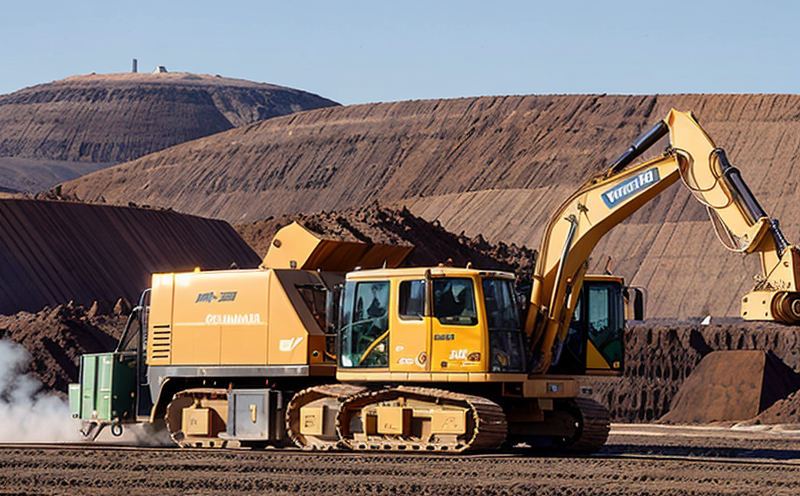EN 16228 Drilling and Foundation Equipment Certification Testing in Mining
The European Standard EN 16228 provides a framework for ensuring the reliability, safety, and performance of drilling and foundation equipment used in mining applications. This standard is crucial for manufacturers, operators, and regulatory bodies to guarantee that drilling and foundation systems meet rigorous quality requirements.
In mining operations, the integrity and functionality of drilling and foundation equipment are paramount. These systems not only enhance productivity but also ensure worker safety by minimizing mechanical failures. EN 16228 addresses these critical aspects through a series of certification tests designed to simulate real-world operating conditions in mines. This standard covers various types of drilling machines and support structures used for excavation, installation of permanent supports, and maintenance.
The testing process under EN 16228 is stringent and comprehensive. It involves multiple stages, including initial inspections, functional tests, durability assessments, and performance evaluations. The standard specifies detailed test procedures to ensure that the equipment can withstand harsh underground environments while maintaining operational efficiency over extended periods.
For mining companies and operators, compliance with EN 16228 ensures they are adhering to international best practices and industry standards. This not only enhances their reputation but also facilitates easier compliance with local regulations and international trade requirements. Moreover, certification under this standard can significantly reduce the risk of equipment failure during critical mining operations.
The testing protocol outlined in EN 16228 is particularly important for large-scale mining projects where the cost of downtime or accidents could be astronomical. By ensuring that all equipment meets the specified standards before deployment, mines can optimize operational efficiency and reduce maintenance costs in the long run.
Furthermore, this standard plays a vital role in promoting sustainable mining practices by encouraging the use of environmentally friendly technologies and materials. The testing procedures ensure that any new or modified equipment is not only functional but also contributes positively to environmental conservation efforts within the mine site.
Applied Standards
The European Standard EN 16228 for drilling and foundation equipment certification in mining is designed to ensure that all equipment used meets stringent safety, reliability, and performance criteria. This standard applies specifically to the design, manufacture, installation, operation, maintenance, and decommissioning of such equipment.
EN 16228 covers a wide range of drilling machines and foundation systems commonly utilized in underground mining operations. These include but are not limited to drill jumbos, roof bolters, and continuous miners. The standard also addresses the safety aspects related to these pieces of equipment, ensuring that they comply with all relevant health and safety regulations.
The application of EN 16228 ensures that mining companies can confidently use certified equipment in their operations. This certification not only enhances operational efficiency but also contributes significantly to worker safety by minimizing the risk of mechanical failures during critical phases like excavation, support installation, and maintenance.
For manufacturers and suppliers, compliance with EN 16228 is essential for ensuring that their products meet international standards and can be trusted in some of the most challenging environments on earth. This standard supports a global market by providing uniformity across different regions, making it easier for mining companies to source reliable equipment.
The application of this standard also promotes sustainability within the mining industry through its emphasis on using eco-friendly technologies and materials. By ensuring that all equipment certified under EN 16228 adheres to these principles, mines can contribute positively to environmental conservation efforts while maintaining operational excellence.
Scope and Methodology
| Aspect | Description |
|---|---|
| Initial Inspection | The process begins with a thorough inspection of the equipment to ensure it meets all specified requirements. This includes checking components for damage, verifying assembly accuracy, and confirming that all parts are correctly labeled. |
| Functional Testing | This involves simulating various operational scenarios under controlled conditions to assess the performance of the equipment. Key parameters such as drilling speed, torque output, and stability are monitored during these tests. |
| Durability Assessment | The equipment is subjected to prolonged stress testing to evaluate its ability to withstand harsh underground environments over extended periods. This helps identify potential weaknesses that may affect long-term reliability. |
| Performance Evaluation | This final stage assesses how well the equipment performs under realistic operational conditions. It includes measuring efficiency, accuracy, and overall effectiveness in completing assigned tasks. |
Customer Impact and Satisfaction
- Increased Operational Efficiency: Compliance with EN 16228 ensures that all equipment operates at peak performance, reducing downtime and enhancing overall productivity.
- Better Worker Safety: The stringent testing procedures under this standard significantly reduce the risk of mechanical failures during critical mining operations, thereby protecting workers from potential hazards.
- Enhanced Reputation: Certification ensures that companies are adhering to international best practices and industry standards, which can enhance their reputation among clients and stakeholders.
- Simplified Compliance: By meeting the requirements of EN 16228, mining companies can more easily comply with local regulations and international trade requirements, streamlining operations across different jurisdictions.
- Cost Savings: While initial costs may be higher due to stringent testing procedures, long-term savings are realized through reduced maintenance expenses and extended equipment life.
- Sustainability: The emphasis on using environmentally friendly technologies and materials under EN 16228 contributes positively to environmental conservation efforts within the mine site.





